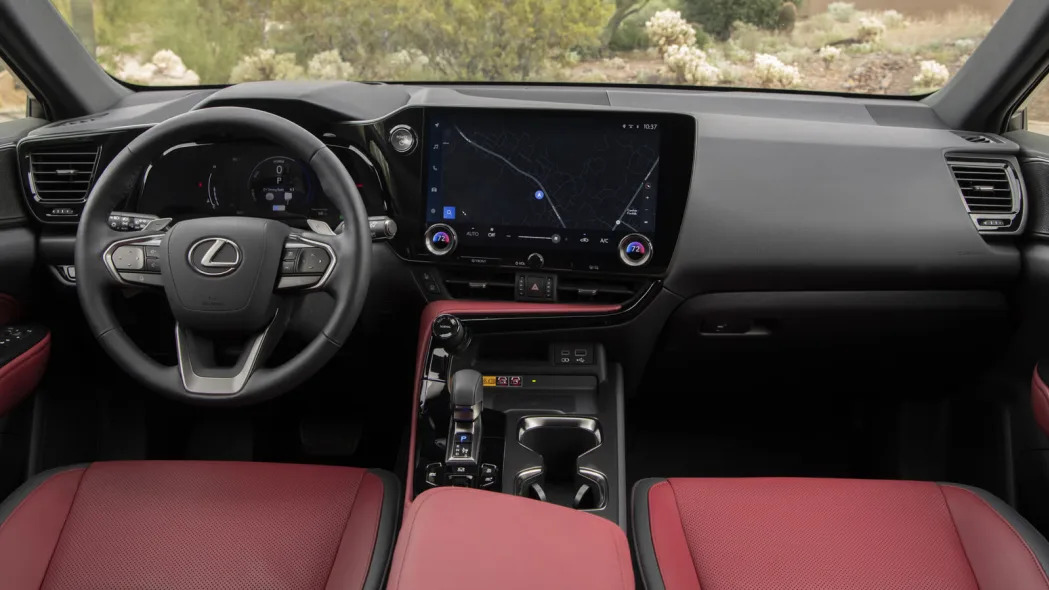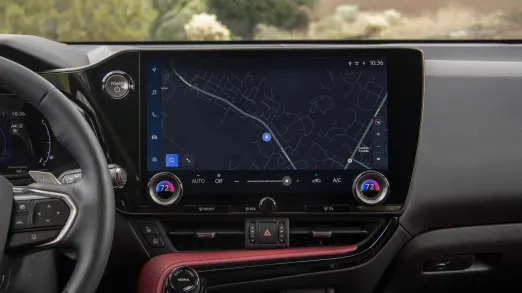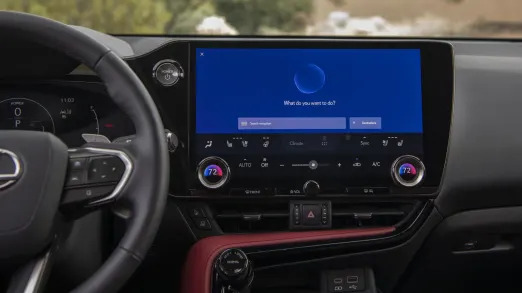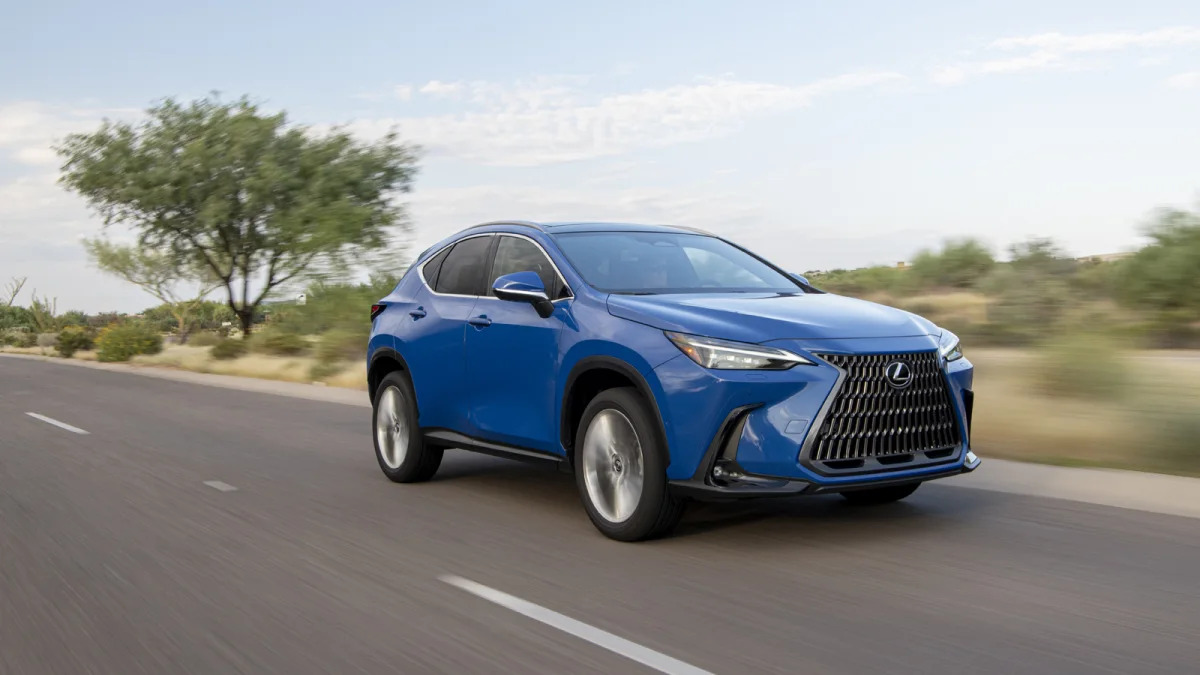The 2022 Lexus NX is at once a safe evolution of the product it replaces and a significant redesign with long-lasting implications. Its dimensions and styling are so similar to the outgoing NX that you'd be forgiven for thinking it's merely a mid-cycle refresh, but indeed, it's a ground-up re-do based on new underpinnings. Sure, they're shared with every front-wheel-drive Toyota group product introduced in the past four years, but then, that's part of the "safe evolution" bit.
Now, there's nothing inherently wrong with such an approach to a new model. Although the NX has never been considered a class leader since it was introduced for 2015, it nevertheless enjoyed strong sales – you know, just like the Lexus ES, RX and name-a-Toyota – vehicles that car enthusiasts might scoff at but everyone else appreciates for their build quality, dependability, resale value and general competence.
Although, if we're talking competence, it's at least worth pointing out one element of the Lexus formula that all those loyal buyers have somehow been putting up with: the Remote Touch tech interface and the infernal touchpad that's been in use, with a few exceptions, in every Lexus since it debuted in … that's right, the original NX. And here's where the long-lasting implications of the all-new 2022 NX come in: Remote Touch is gone and in its place the new "Human Machine Interface" touchscreen infotainment system will be making its way through the brand. This is a very big deal, because it means a very real and annoying reason for not buying a Lexus is about to go away … and isn't present at all in the new NX.

That said, the new touchscreen not only represents the most important change and improvement to the NX, but the most significant missed opportunity. We’ll cover that in-depth in a followup infotainment review, but in short, the system thinks too highly of voice commands and could really use the ability to show multiple sources of information at once. Otherwise, the two available touchscreens (a base 9.6-inch unit and a 14-inch widescreen upgrade) feature a UI that's quicker, prettier and easier to use. I was able to jump into the new NX and quickly figure it all out, which definitely can't be said of other luxury systems that continue to perplex after multiple uses, including Mercedes’ MBUX and Remote Touch.
Those trims with the 14-inch screen also pair with a unique set of steering wheel buttons. They are unmarked – their functionality is indicated by pop-ups in the also-included head-up display. This is a novel idea, but it's a bit confusing, and if you have polarized sunglasses that wipe out a HUD, good luck.
Like the new touchscreen, that HUD-steering wheel combo is sure to spread throughout the Lexus family, but that's not all. The switchgear is new, including the drive mode selector, Prius-like electronic shifter and unusual electronic door openers, while the overall design aesthetic is a significant departure for the brand. It's more driver-focused, but it's also less distinctive than an IS, for instance, and the plain expanse of black dash on the passenger side is a bit 1998. Materials and build quality remains up to the usual high Lexus standard.


In terms of space, the 2022 NX is virtually identical to the compact SUV it replaces. There are no appreciable gains in exterior dimensions or passenger space, though cargo room increases by 5 cubic-feet. The NX therefore remains the smallest compact luxury SUV, and although its exterior dimensions significantly exceed subcompacts like the BMW X1 and Mercedes GLA, its interior dimensions are actually pretty similar.
Like every new Toyota/Lexus on the TNG platform, the new NX enjoys substantial improvements to its reflexes and refinement. In short, it's much better to drive, but still not that great to drive. The suspension is more controlled, yet the ride quality is improved. The steering is a little bit lighter at lower speeds (at least in Normal mode), but it's more precise, communicative and ultimately feels less artificial. Sport mode provides a subtle, just-right uptick in effort. The F Sport's added Sport+ mode hastens the frequency of downshifts, while its adaptive dampers appreciably tighten handling.
The new platform also brings with it an all-new and expanded powertrain lineup. The NX 250 base model and its 2.5-liter naturally aspirated four-cylinder are both new to the NX. It's paired with an eight-speed automatic and produces 203 horsepower and 184 pound-feet – just as that engine does in its TNG relative, the Toyota RAV4. This version was not on hand at the first drive event, but given that this engine is an unremarkable low point in a RAV4, it's hard to imagine it being considered a plus in the NX. The new hybrid powertrain in the rechristened NX 350h is similar to what's in RAV4 and Venza, but produces 239 total system horsepower versus 219 (possibly due to its premium fuel recommendation). Fuel economy is basically the same at an estimated 39 miles per gallon combined.


Driven back to back with the outgoing NX 300h hybrid, the improvements are obvious. The new hybrid system is both gutsier, with a 0-60-mph reduction of 1.5 seconds you definitely notice, and it's more refined. The engine is quieter, and the electronically controlled CVT doesn't yo-yo revs as much when alternating on and off the throttle. It draws less attention to its hybridness, which is always a good thing.
The other two powertrains are not shared with the RAV4 or Venza. The NX 350 and its new 2.4-liter turbocharged inline-four good for 275 hp and 317 lb-ft of torque thoroughly shellacs the old NX 300's 2.0-liter turbo-four that put out 235 hp and 258 lb-ft. It brings the turbo NX from one of the weakest compact luxury SUVs to one of the strongest. That output exceeds the BMX X3 xDrive30i, Mercedes GLC 300 and Acura RDX, especially in terms of its torque. That can be attributed to its greater displacement relative the others' 2.0 liters, which means it doesn't have to rely on its turbocharger as much to generate low-end power. The power delivery is smooth and consistent, though the turbo NX can hardly be considered a performance-oriented choice, even when paired with the sport-tuned F Sport model. Its estimated 0-60 time of 6.6 seconds is also about a half-second slower than the X3 and GLC despite its power advantage.
Ultimately, the most appealing powertrain option is found in the new NX 450h+ plug-in hybrid. Its electric motor provides the smooth, effortless punch expected of a PHEV, while limiting engine intrusion beyond even the new-and-improved regular Hybrid when its all-electric range is exhausted. And although it certainly shares components with the RAV4 Prime plug-in hybrid, along with its 302 total system horsepower, there are key differences.
According to Lexus product education manager Paul Williamsen, the NX 450h+ has a different battery pack. Whereas the RAV4 Prime effectively combines the regular RAV4 Hybrid's battery pack with a second, larger, plug-in-able battery dedicated to the all-electric range, the NX has a single massive pack that keeps enough juice in reserve once the all-electric portion is drained to run the car as a normal hybrid. This allows the NX to fully replenish its electric range using only the engine. While the RAV4 Prime's "Charge" mode can restore a good chunk of its total potential range, it needs a wall charger to be fully topped off.
The NX also uses the coolant system to keep the batteries happy, which increases energy output, especially in hotter climates. None of the above improves efficiency ratings relative the RAV4, however. The NX 450h+ has an EV range of 37 miles versus the Prime's 42. It's also 0.2 second slower and is rated at 84 MPGe versus 94 MPGe. Extra weight is the likely culprit, but still those figures are vastly superior to the other plug-in-hybrid compact luxury SUVs.

As such, the hybrids are the most competitive versions of the 2022 Lexus NX since their fuel economy gives it something that few rivals can match. Then again, the turbocharged, AWD-only NX 350 undercuts the X3 and GLC by about $5,000 – the NX 350 F Sport is similarly priced as those competitors, but like all NX versions, provides more features for the money. That includes the full menu of driver assistance tech, including adaptive cruise control. The NX 350h hybrid starts at basically the same price as the turbo (around $43,000, including destination), but can't be paired with F Sport. The NX 450h+ is only offered in loaded Luxury or F Sport guises, both of which go for about $57,000 before what is likely to be a $7,500 tax rebate (at least for those buyers who qualify).
So on paper the NX makes sense, and it's definitely improved over its predecessor. It's just hard to get very excited about it. The looks are almost identical to the old one and although better to drive, it's just not as compelling an effort as the various rear-drive Lexus models or top competitors. This is probably why the interior plays such a starring role. The improvements are bound to please all those current but it's hard to see many new folks being enticed.
Related Video:










Sign in to post
Please sign in to leave a comment.
Continue